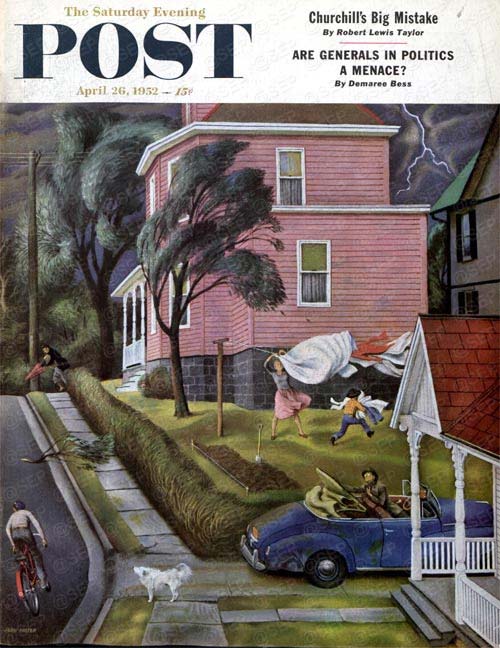
by John Falter
April 26, 1952
In a contemporary description of this cover, Post editors wrote that artist John Falter remembered well the spring storms from his Midwestern childhood in Nebraska and the way trees turned up the undersides of their leaves and looked like phantoms.
His more than 125 Post covers depicted everyday life, and often its foibles. (See “John Falter’s August.”)
Falter was known for his masterful use of outdoor light, reflected here with quickly disappearing patches of light and just as rapidly darkening skies.
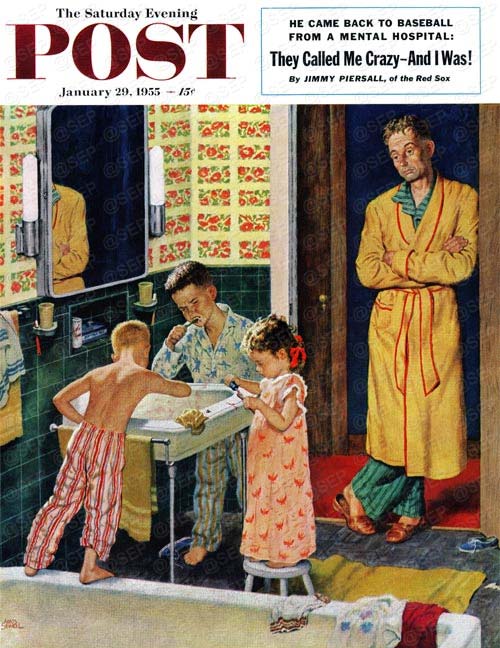
by Amos Sewell
January 29, 1955
According to a 1938 article in the Post, San Francisco-born artist Amos Sewell worked at a bank for several years, studying art in the evenings and spending vacations sketching up and down the Pacific coast. Then “in 1931, right in the middle of the depression, (Sewell) decided he was tired of the banking business and shipped out as a work-a-way on a lumber boat bound for New York, via the Panama Canal.”
In spite of his earlier vagabond lifestyle, many of Sewell’s 45 covers are notable for their homespun quality. Prime examples include this 1955 suburban toothbrushing scene, a father assembling a swing set (see “Thanks, Dad!”), and a little boy playing cowboy (see “Romance of the Cowboy”).
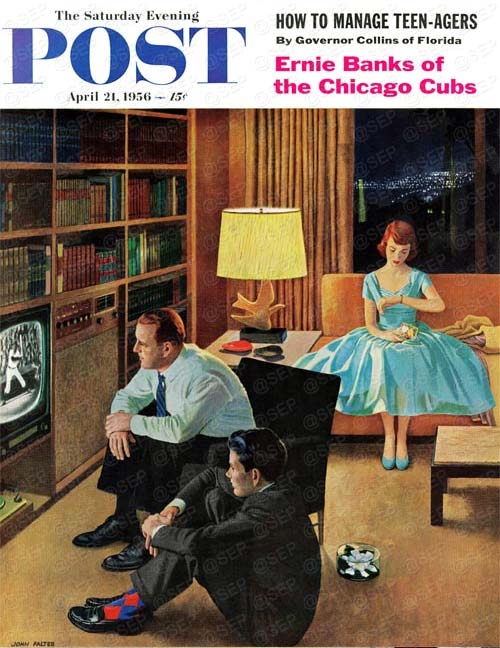
by John Falter
April 21, 1956
It all says mid-1950s: the TV, the dress, the lamp, the ashtrays… we have everything but tailfins here in this portrait of teenage angst.
The urbane setting (note the glittering city lights in the window) seems far removed from John Falter’s corn-fed Nebraskan boyhood. But let us be reminded of the artist’s meticulously rendered cityscapes as featured in “Can You Guess the City?”.
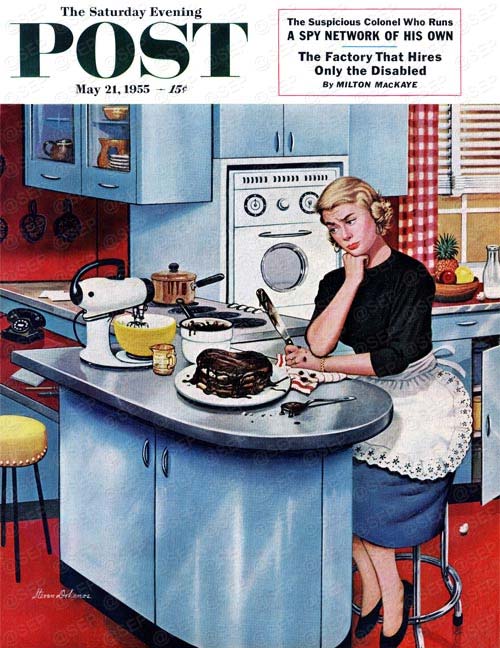
by Stevan Dohanos
May 21, 1955
Adept at drawing humor from everyday life, Stevan Dohanos’ covers include a toddler in a bedroom happily emptying purses as grown-ups gather in the next room and a woman “on vacation” at a beach cabin. (See “The Great Covers of Stevan Dohanos.”)
About this 1955 kitchen scene, Post editors wrote: “These newfangled kitchens certainly have helpful equipment, such as wall ovens with windows so one can watch a cake fall.”
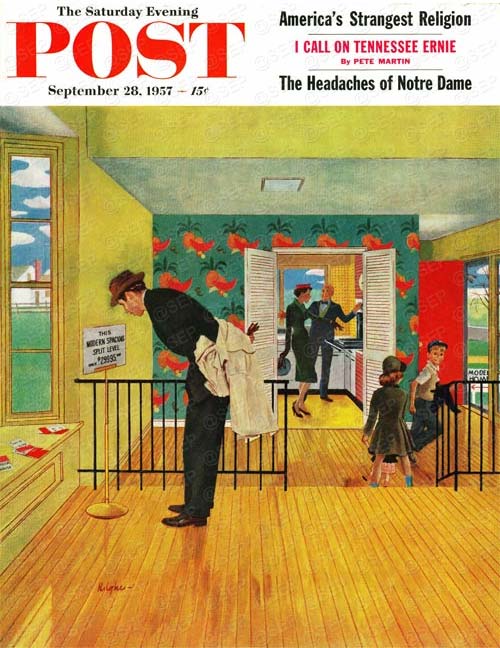
by George Hughes
September 28, 1957
Artist George Hughes favored vibrant colors and upper-middle class settings. Because the family is fashionably attired, we might assume some level of affluence. Even so, the average home was around $18,000 in 1950, and the sign in this model home states: “This modern spacious split level: $29,995.00.” No question that the family breadwinner is feeling a degree of sticker shock.
On the inside cover of this issue, Post editors quipped that Hughes himself had just purchased a new, one-level home in Vermont “because he is too old a man to climb steps.” Hughes would have been in his 50s at this time, but this sort of teasing banter was typical of the artist/editor relationship.
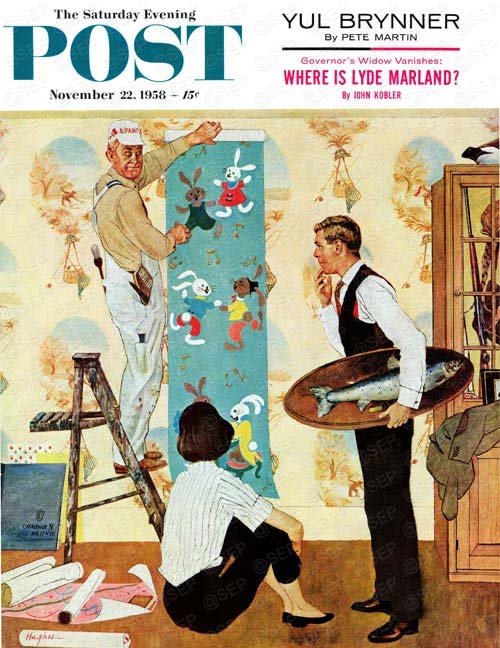
by George Hughes
November 22, 1958
Post editors wrote that the wallpaper with whitewater fishing scenes in Dad’s den is going, and he would soon be a “displaced person.” As the father of two young girls, illustrator George Hughes could certainly identify with turning man caves into kid’s rooms.
Renovation may have also been on his mind because the artist had recently moved from New York City to Arlington, Vermont, in part, to be near other Post artists like Norman Rockwell and Mead Schaeffer.
The country air must have suited Hughes, as the ’50s saw 80 George Hughes covers, making him the most prolific Post artist of the decade. By comparison, other prominent cover illustrators like Richard Sargent and John Falter did 35 and 60 covers, respectively (Rockwell did 45).
Reprints are available at Art.com.
Become a Saturday Evening Post member and enjoy unlimited access. Subscribe now
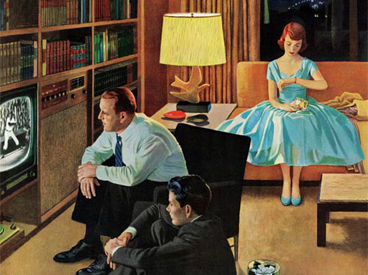


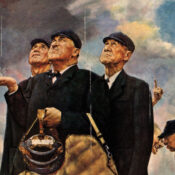
Comments
I’m looking for a place to sell my copies of The Saturday Evening Post May thru June 1956.
‘Spring Storm’. Love John Falter, and this cover is a favorite. You can really FEEL that powerful wind kicking up warning you a severe storm is only a few minutes away. I hope that man gets the top up on that blue convertible. Very scary sky indeed.
Amos Sewell’s ‘Brushing Their Teeth’ is brilliant. Dad’s tired and needs his sleep–NOW!
‘Date With Television’ is another Falter masterpiece. Although present-day (for ’56) this cover has elements of the “Futuristic Fifties” as well.
‘First Cake’ is one of Dahanos’ best covers. Obviously the cake DID fall, but I’m sure subsequent efforts materialized nicely overall after that.
‘Den into Nursery’ by Hughes is excellent. One can only imagine what type of covers he would have drawn in 1968 (ten years later), in regard to domestic life!